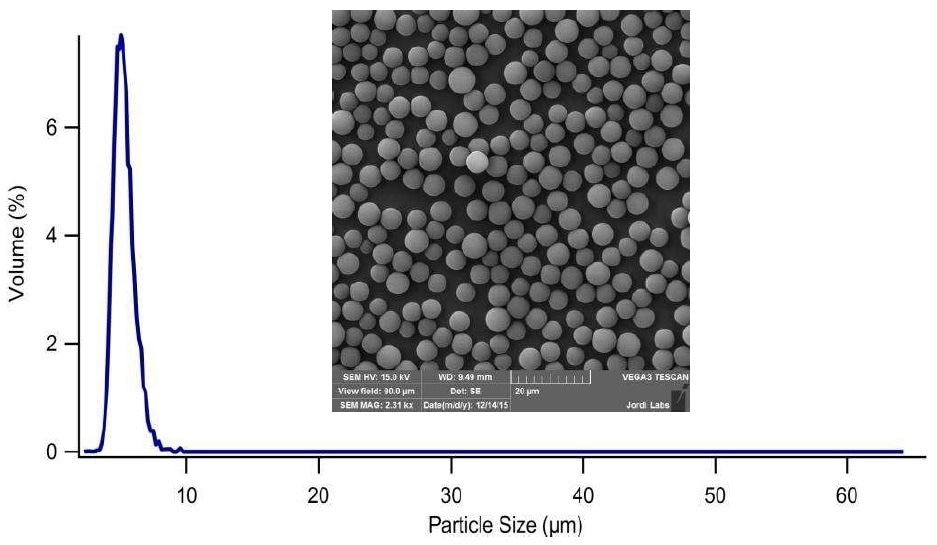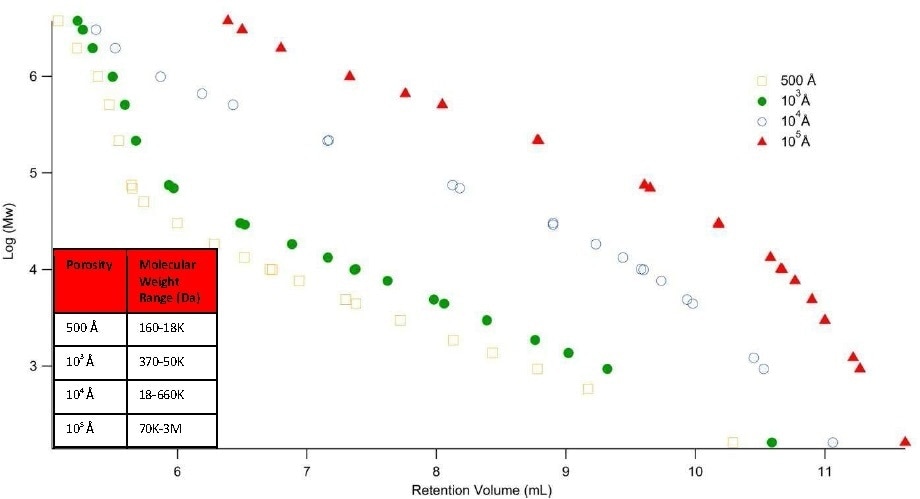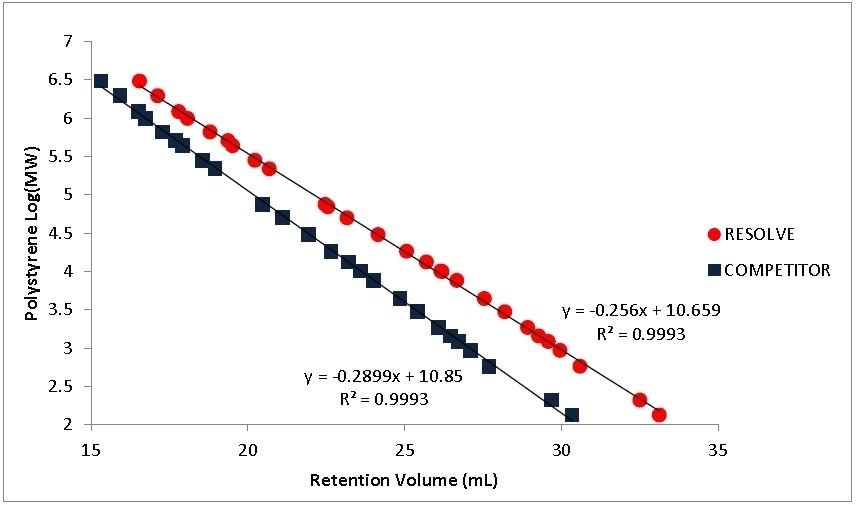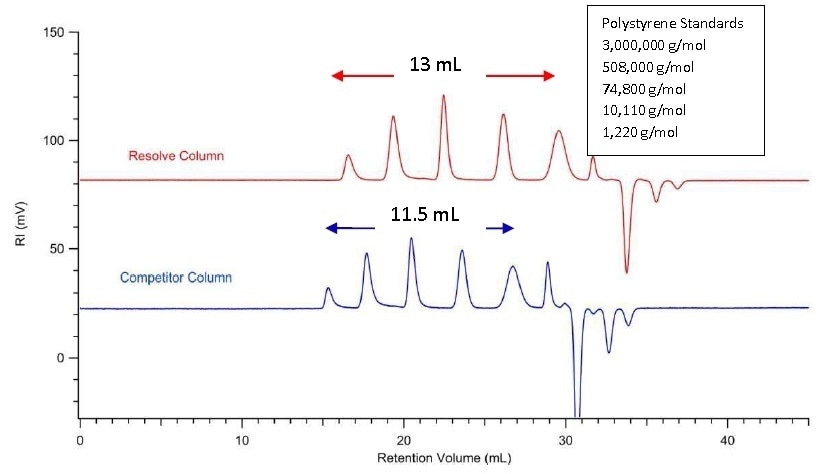Molecular weight is an important characteristic of all polymers and strongly affects polymer properties. Most rheological and mechanical properties are a linear function of molecular weight. Therefore, molecular weight is important for the development and manufacturing of polymeric materials.
Gel Permeation Chromatography (GPC), also called Size Exclusion Chromatography (SEC), is a popular technique for measuring the molecular weight distribution of macromolecules. Based on the size, the separation takes place in GPC. Compounds are kept for different periods of time based on their access to the permeable structure of the chromatographic packing. The smaller analyte molecules more easily enter the pores and as a result, spend more time in these pores, causing increased retention time. On the other hand, larger analyte molecules spend less time inside the pores and are eluted rapidly. Chromatographic separation is thus based on hydrodynamic volume (size in solution).
Sample components are dissolved in an appropriate solvent during standardized GPC, and they are separated chromatographically based on molecular size, detected by means of a Refractive Index detector and compared to known molecular weight standards. Determinations of absolute molecular weight can also be performed by combining viscometry and light scattering detection to a GPC separation.
New Packing Material for GPC Systems
In GPC, the mobile phase dissolves the sample and carries it through the column. There is no interaction between the stationary phase and the analyte molecules under ideal conditions. A suitable combination of mobile phase and column stationary phase is necessary to achieve a purely size based separation. Recently, Jordi Labs has developed a new packing material for GPC systems. Based on 100% divinylbenzene, this column packing provides improved mechanical stability and utilizes a new synthetic method which produces a monodisperse polymer column packing.
It is well known that broad particle size distributions in particle-based columns creates variations in packing density, reduces the column permeability, produces high back pressure, and lowers column resolution. New generation of Jordi GPC columns, made with monodisperse 100% divinylbenzene particles with finely controlled pore structure and precisely controlled particle diameter, provide high separation capacity, high efficiency and low back pressure with better bed stability.
Figure 1 shows scanning electron micrographs and particle size distribution of 5 μm macroporous column packing material with 103 Å pore sizes. The perfect spherical shapes and uniform size distribution are clearly seen.

 Please click here if you would like more information on the product in this article or a quote
Please click here if you would like more information on the product in this article or a quote

Figure 1. Scanning electron micrograph and particle size distribution of Jordi Resolve 5 μm column packing material with 103 Å pore size.
To maximize GPC resolution, the key is to employ a column with the maximum number of pores of the desired size in order to separate the molecular weight range of interest. As shown in Figure 2, new generation individual pore size Jordi Resolve columns 5 μm (7.8 mm ID x 300 mm L) provide high resolution in particular molecular weight ranges. The linear portion of each calibration curve describes the molecular weight range of every individual porosity column. Jordi Labs developed mixed bed 5 μm Resolve columns (7.8 mm ID x 300 mm L) in order to cover a wider molecular weight range with a stable resolution for the analysis of unknown or polydisperse materials.
Mixed bed Resolve column enables separation over the molecular weight ranging from 160 to 3,000,000 g/mol (PS equivalent) with a coefficient of determination (R2) of 0.999 (Figure 3) and an industry-leading specification of 70,000 theoretical plates. Lower slope of the calibration curve (13%) of Resolve mixed bed column, as opposed to the competitor column of the same particle length and size, shows that Resolve column offers excellent separation with more accurate molecular weights (Figure 3).
Obviously, the high pore volume of Jordi Resolve columns offers increased resolution as specified by the chromatograms in Figure 4. Accurate blending of a large amount of individual pore size gels produces smooth peak shapes and a wide linear molecular weight range. As illustrated in Figure 5, analyzes of broad distribution polymers attained using Jordi Resolve column demonstrate high resolution without any shoulders or dislocations.

Figure 2. Calibration curves of individual pore size Jordi Resolve 5 μm columns. Mobile phase: tetrahydrofuran, flow rate: 1.0 mL/min, sample: polystyrene standards, injection volume: 100 μL

Figure 3. Calibration curves of three column set of Jordi Resolve Mixed Bed 5 μm column (7.8 mm ID x 300 mm L) and the competitor column. Mobile phase: tetrahydrofuran, flow rate: 1.0 mL/min, sample: polystyrene standards, injection volume: 100 μL.

Figure 4. Overlay of chromatograms of 5 polystyrene standards obtained with three column set of Jordi Resolve (7.8 mm ID x 300 mm L) and the competitor column. Mobile phase: tetrahydrafuran, flow rate: 1.0 mL/min, injection volume: 100 μL.

Figure 5. Analyzes of broad distribution polymers. Columns: 3x Jordi Resolve mixed bed 5 μm (7.8 mm ID x 300 mm L), mobile phase: tetrahydrofuran, flow rate: 1.0 mL/min, injection volume: 100 μL.

This information has been sourced, reviewed and adapted from materials provided by Jordi Labs.
For more information on this source, please visit Jordi Labs.